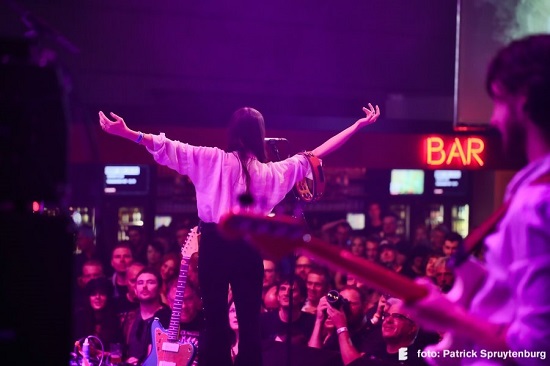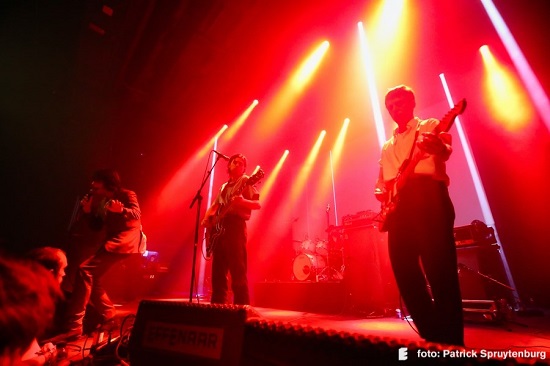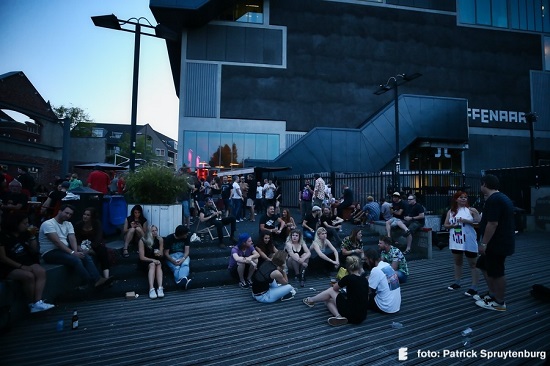With their inaugural Eindhoven festival last year, DIY psych and noise label Fuzz Club crafted an important new landmark for those interested in music’s weird and wonderful outer reaches. At De Effennaar last summer, we went with concerns about the viability of a festival like this, considering the apparent decline in popularity of the sort of psych and noise music it celebrates, but departed re-invigorated, such was the strength of community there. Point now proven, the second edition feels like a consolidation. Having succeeded in proving the health of their community, Fuzz Club is now establishing itself as a proper annual hub within it. There’s a warm sense of familiarity as you wander about the small courtyard, buzzing with friendly faces, bands and fans alike. Inside, too, you quickly slip back into last year’s routine. One set in the larger upstairs room is followed immediately by another in the smaller downstairs face, crowds eager to catch everything.
It’s even more heartening to find that there’s been progression for Fuzz Club too, most notably in Sam Wiehl’s visual work. In the upstairs space there are six large screens, displaying surreal and disorienting 3D animations, mixed live in time with the musicians on stage. Downstairs, visual artist Innerstrings controls two huge screens, one either side of the stage, that distort visuals of the bands themselves, melting images of the musicians into the background and solidifying them again. There are more people here than last summer, just reward for Fuzz Club’s marked step forwards as hosts.
It’s within this atmosphere of a comforting welcome back, as well as splendid psychotropic staging, that we see Tucson, Arizona mountain drone merchants The Myrrors. By now, the kind of music they make, long-form, hypnotic walls of unfiltered psychedelic power, garnished with looping riffs and chimes, is familiar. It feels almost like the staple aesthetic of the scene. So good are The Myrrors at playing this kind of music, however, that familiarity works in their favour, their set becomes an early reminder of how joyous this kind of noise can be.
Straight afterwards, downstairs, Medicine Boy are less easily pinned down. Their sound is dynamic and shapeless, constantly moving and mutating like a cloud of smoke. They can move slowly, allowing themselves to be swallowed by darkness and gloom, and they can sear out of the traps without warning with a straight up attack of hard-riffing fuzz. Froth follow on the same stage, shoegazers on the surface, but without the languidness that curses so much of that genre’s modern pack. They hide moments of spikiness and aggression in the swirl, and moments of real melodic beauty too. The influx of bands like this affirms that with their second edition Fuzz Club has become a broader church than ever.

Later, The Underground Youth are playing upstairs, a band who in many ways encapsulate the very heart and soul of the festival. Like many of the acts, they were here last year too, and are signed to Fuzz Club’s label. “Between everyone who works at Fuzz Club, all the bands we’ve known and played with for years and all the fans who’ve been at the shows supporting that scene since the beginning, it really was the perfect way to celebrate making it that far,” the band’s Craig Dyer said of last year’s show, when we caught up with the band pre-festival. His words reflect a sense of shared purpose between the label, the bands and the crowd, and this set feels like something of a flashpoint, an explosion of energy helmed by the safest of hands.
The following day, the sun shines even brighter. We enter through the courtyard, where the same faces lounge around the pond, a DJ easing them into the evening. Upstairs, Les Big Byrd are playing. This writer first saw them at Fuzz Club’s erstwhile predecessor Liverpool Psych Fest about half a decade ago, and in many ways they’re the same proposition. Frontman Jocke Åhlund is still in military overalls, and still a freewheeling stage presence, while their music is still blissful, beefy kraut-prog jams of the highest order. They end the show as if they’ve just headlined, guitars tossed aside, Åhlund reaching into the crowd, keen to shake every hand like he’s just played the gig of his life.

Like The Myrrors, Les Big Byrd show that there’s a lot to be said for the power of continuity when it comes to a festival like this. The knowledge that there will always be bands like this, providing the kind of music that holds such specific appeal to a specific (and loyal) group of fans, is what fosters the sense of community so integral to its success. That said, there is of course the risk of going stale, the constant need to evolve, however successful your foundations. What’s reassuring then is that Fuzz Club have got the balance just right, they have maintained what was so lovely about last year, without being afraid to sew the seeds of progression.
Booking Iceage as headliners is the festival’s masterstroke, a band no longer just punk but something progressive and individual, and a band who are on stunning form as live performers. Frontman Elias Bender Rønnenfelt, has an unreal magnetism, his aggression tempered with a deftness of touch, a lightness on his feet and a swaying confidence. The band have evolved from the scrappy punk of their early days into a devilishly tight group, relentless in their energy, genuinely jaw-dropping when they ramp things up as one. Though the gigs will continue late into the night, theirs feels the most special of the lot, the conclusive statement of a festival that has begun the perfect evolution.


